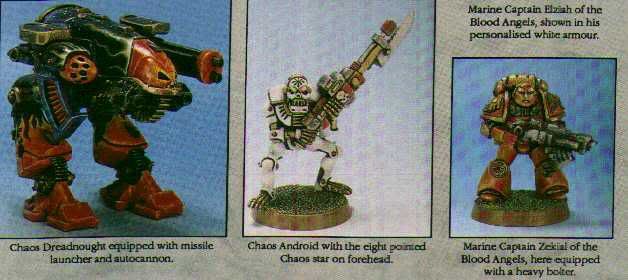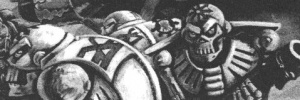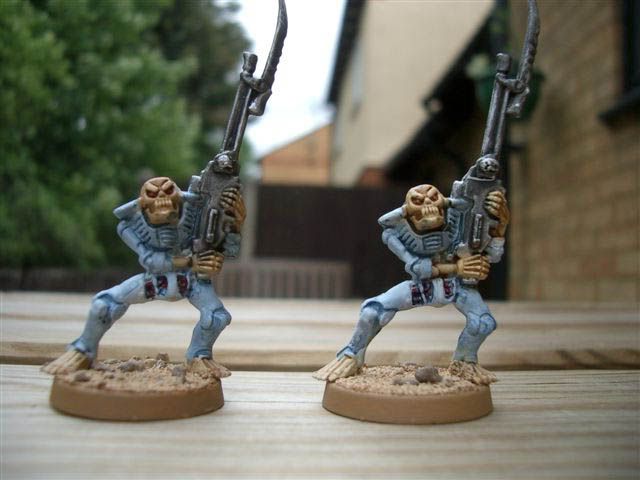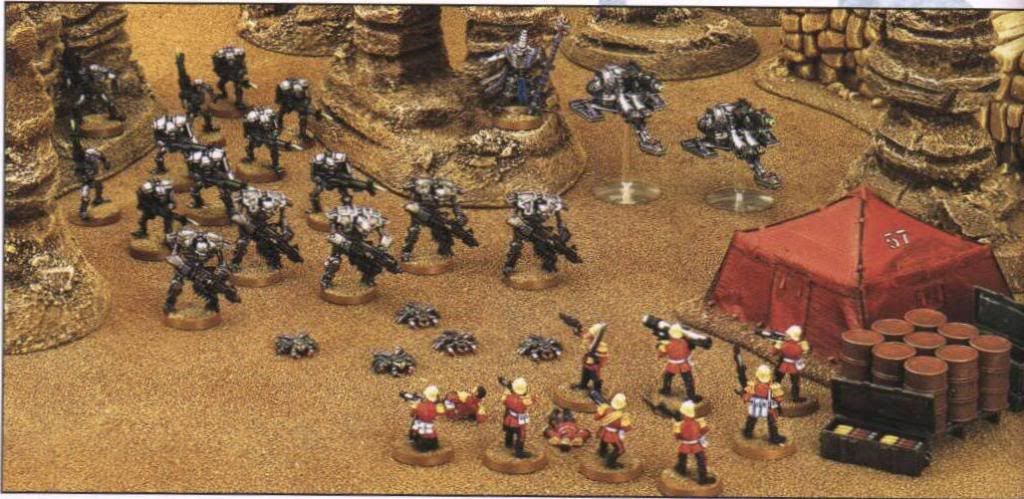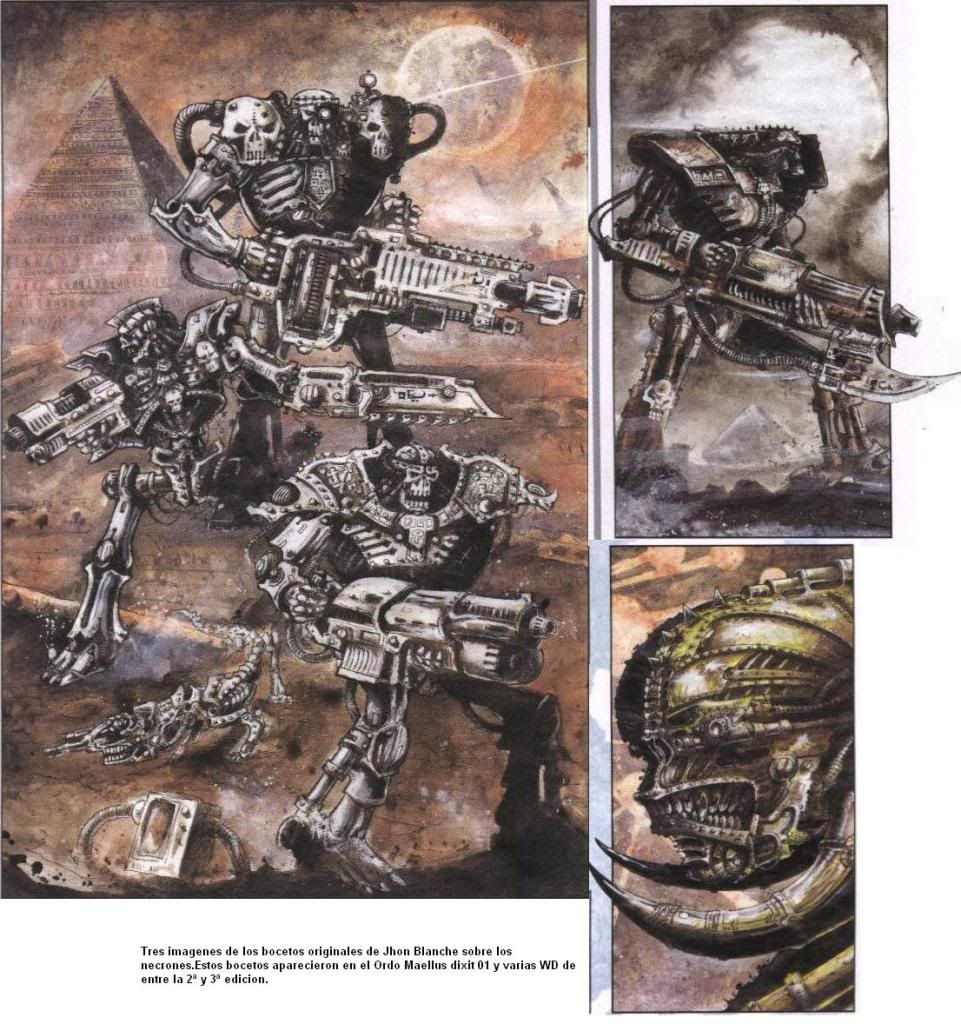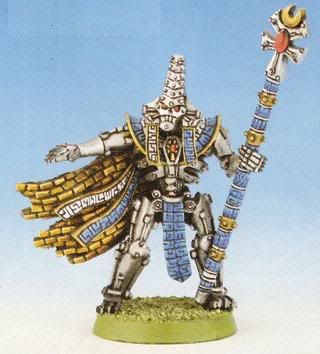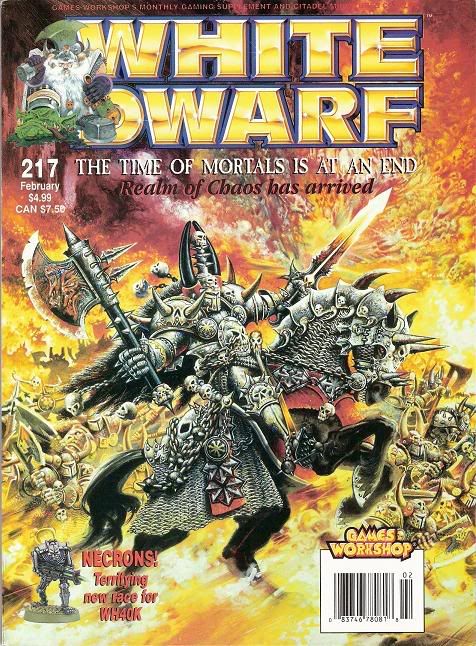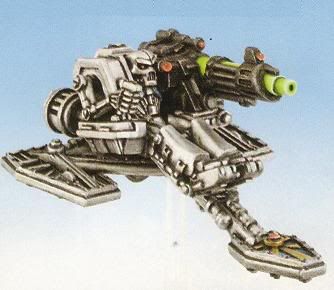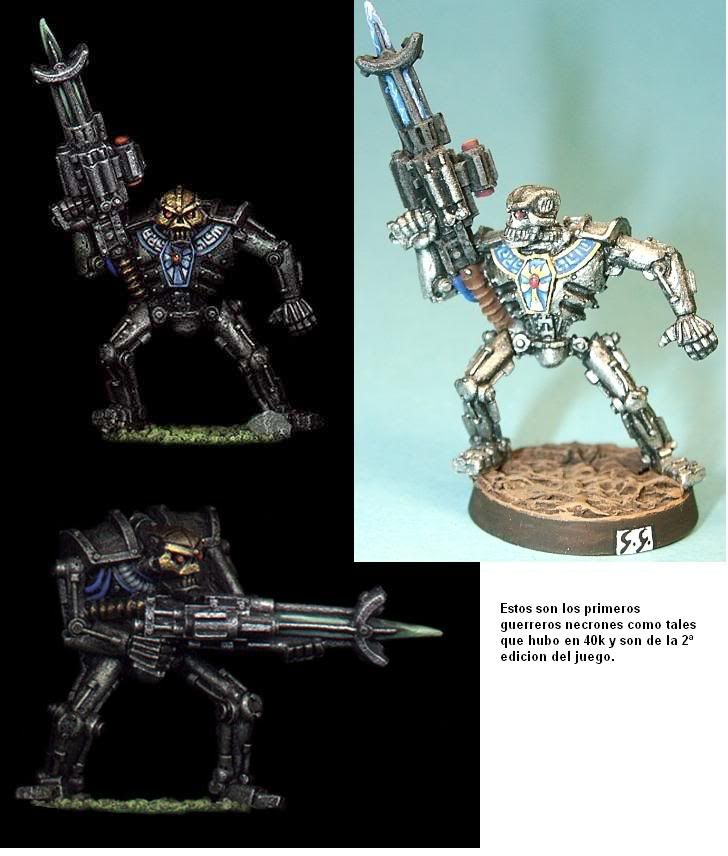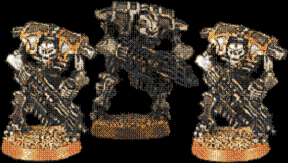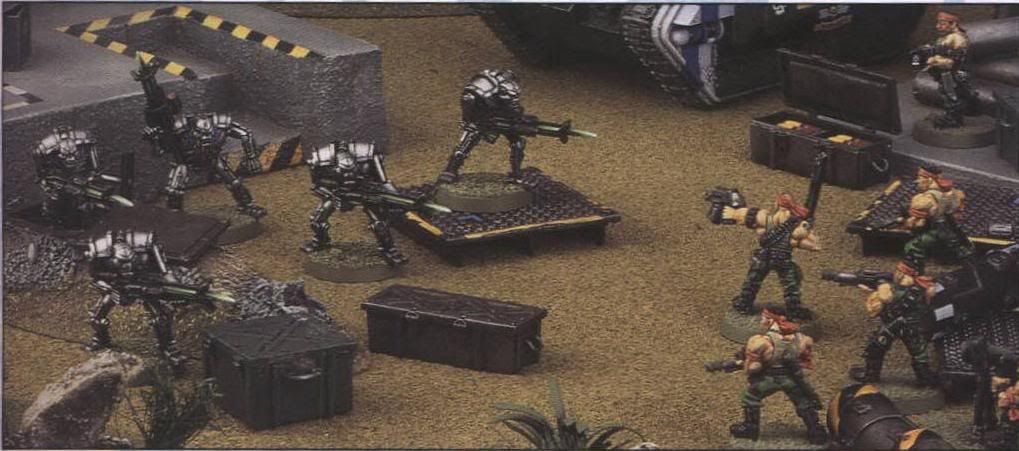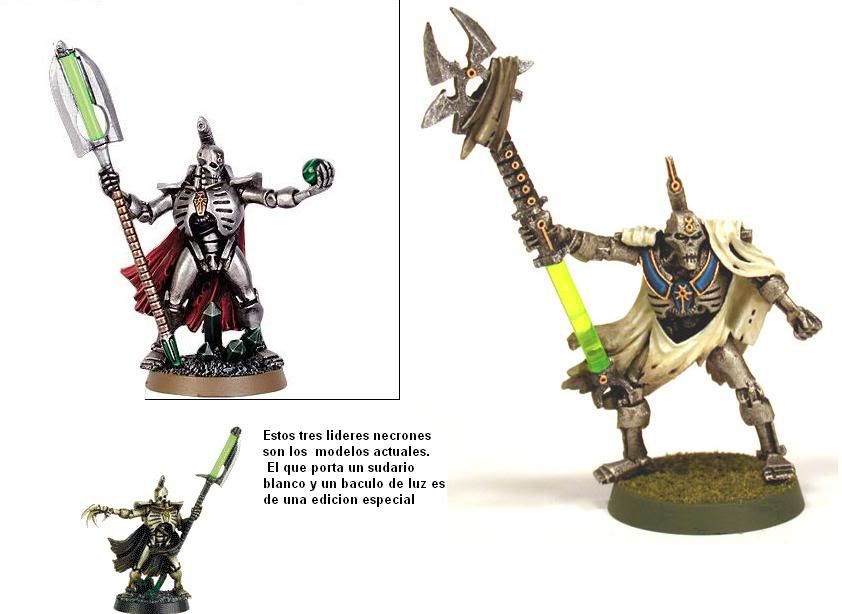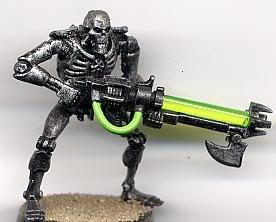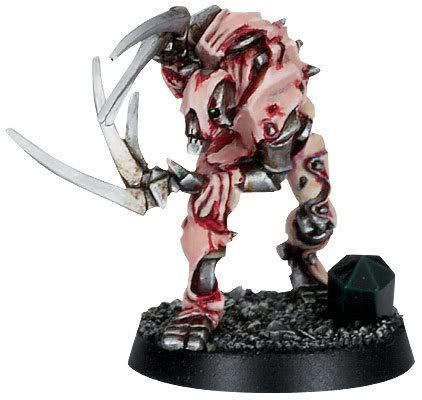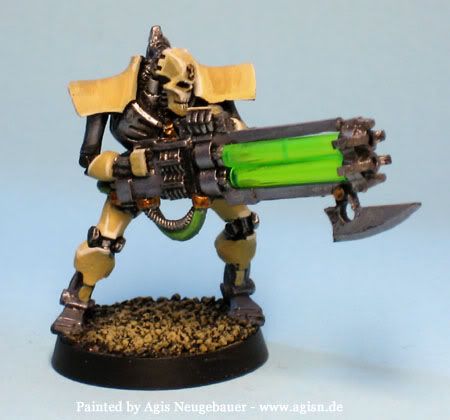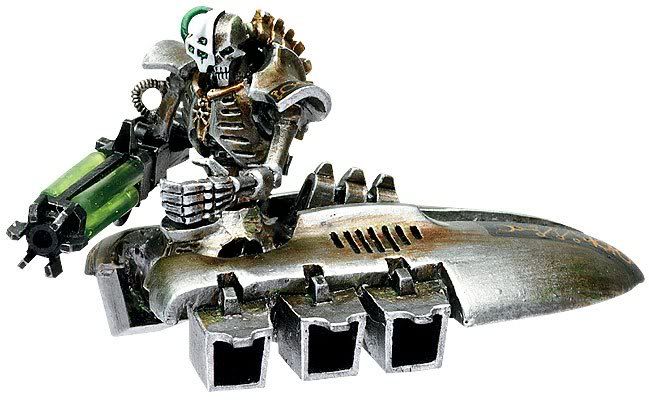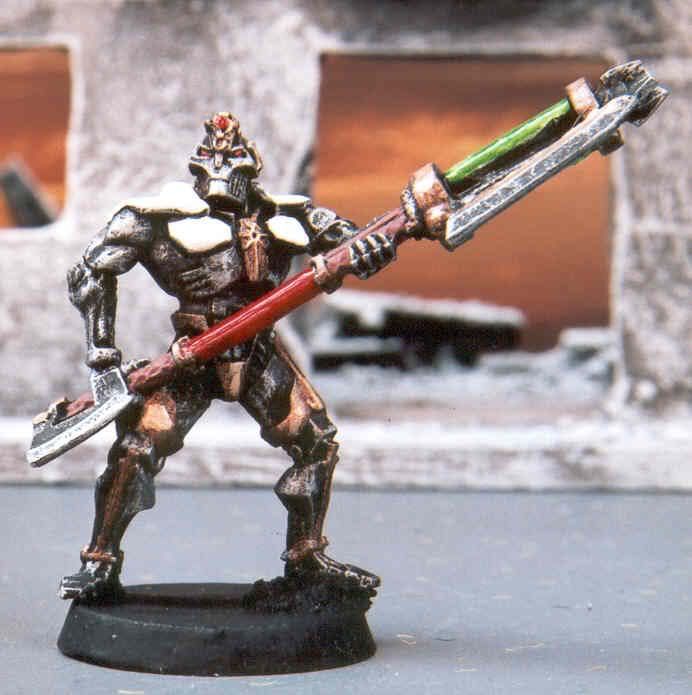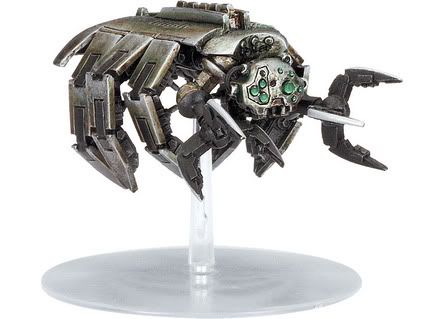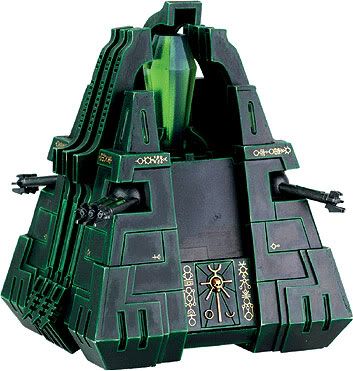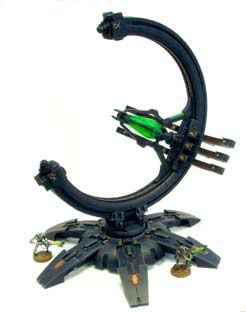[English version below.]
¡Hola de nuevo, y perdón por el largo retraso!
En esta ocasión, aprovechando que ya he empezado con los Necrones, quiero enseñaros este completísimo artículo que encontré y copié tal cual está del foro español Capa sobre Capa. Espero que os guste tanto como a mí, porque está muy completo y bien ilustrado.
Atte.,
Aresius.
PD: Gracias por haber superado las 1000 visitas, de todo corazón. Le anima a uno a seguir con esto =)
PD: Gracias por haber superado las 1000 visitas, de todo corazón. Le anima a uno a seguir con esto =)
* * *
Los necrones, que a día de hoy son junto con Cazadores de Brujas la única raza del juego que tiene un codex de 3ª edición, han tenido unos orígenes históricos fuera del juego realmente curiosos.
La primera aparición de los necrones como miniaturas fue bajo la apariencia de androides del Caos:
En el año 1990, GW y MB juntan sus fuerzas y lanzan un juego con clara inspiración en pelis como Alien de James Cameron: el Space Crusade, Starquest, o mejor dicho, el Cruzada Estelar. Entre las minis hay dos bandos: marines espaciales (“Legionarios Espaciales”) y Aliens, y es entre los Aliens donde encontramos el primer ejemplo de Necrón: el androide del Caos.
La primera aparición de los necrones como miniaturas fue bajo la apariencia de androides del Caos:
En el año 1990, GW y MB juntan sus fuerzas y lanzan un juego con clara inspiración en pelis como Alien de James Cameron: el Space Crusade, Starquest, o mejor dicho, el Cruzada Estelar. Entre las minis hay dos bandos: marines espaciales (“Legionarios Espaciales”) y Aliens, y es entre los Aliens donde encontramos el primer ejemplo de Necrón: el androide del Caos.
Pese al nombre, la estrella de ocho puntas en la frente y la especie de espingarda con bayoneta que le ponen se puede ver sin error alguno un proto-Necrón. El juego fue evolucionando con diferentes ampliaciones que incluían más razas y vehículos, usando como fuente de inspiración películas como “Robocop” (para el dreadnought) o algunas más antiguas como “Star Trek” (para los Eldar) o la primera de "Terminator" (1984) para estos androides. Las figuras van siendo aceptadas por los “hermanos mayores” de los otros juegos de GW y se decide, años mas tarde, exportarlos a otros juegos basados en 40k, como el Epic.
Corría el año 1992 y hacía un año que se había estrenado “oursales 2, el Juicio Final” (acordaos de You could be mine de Guns & Roses) y al parecer integraron dentro de las armerías del Caos que salían en el suplemento de “Epic: Renegades” los androides del Caos, como tropas de Khorne. Se decidió darles entonces algo más de trasfondo para ver de dónde salían. Estos eran unos autómatas de plastiacero hechos por los Squats del Caos que, con ayuda de hechiceros esclavos, eran animados por un demonio menor que los poseía. Como recordaban a los terminators de James Cameron, gustaron mucho (que nadie diga nunca que la GW no tuvo sentido de la oportunidad…). Aun así, la GW no se decidió del todo con ellos.
Había pasado bastante el tiempo y el interés por ciertos juegos de MB decaía poco a poco en USA e Inglaterra (en España por ejemplo duraría un poco más al llegar más tarde). Sin embargo, había cierto gusto por algunas miniaturas como los androides, que en aquella época eran difíciles de conseguir por separado del juego. A pesar de todo, no se integraron en ninguna lista de ejército de forma clara y la gente se los fue quedando como algo para pintar y meter en la vitrina. A mí personalmente ni me parecían feas ni bonitas pero el arma era algo fina y ridícula para la mini en sí.
Pero algunos diseñadores de juegos a finales de los 90 no se habían olvidado de estos androides y se decidieron a sacarlos como ejército independiente. Sin embargo, con la desaparición de los Squats del juego (mal exterminados y sacados del juego por un jaleo de copyright) no había forma de sacarlos en un, por ejemplo, “Codex: Squats del Caos” y así tener la contrapartida de los Enanos del Caos de Fantasy en 40k.
Además, el Caos entre marines, demonios, cultistas y demás tenían tropas de sobra, ¡entonces para qué más!
Así que, como la idea de unas máquinas asesinas que atacan sin provocación y de forma despiadada a sus enemigos gustaba, salieron los primeros Necrones como tales.
Pese a que los dibujos de John Blanche seguían inspirándose mucho en la estética de Terminator, se les empezó a dar un trasfondo de raza antigua prehumana, con un aspecto pseudo egipcio-mesopotámico-precolombino, todo junto y mezclado como una ensalada histórico-cultural.
Como ejemplo clásico el líder Necrón, el primero de su clase:
El “Codex: Necrones” fue el último codex de la 2ª edición y salió en los últimos momentos de vida útil de esta (1998, aproximadamente), tan justo que no tuvo ni libro ni fascículo como otros de los últimos de esa edición (Asesinos y Hermanas de Batalla). Salió en
Más o menos en aquella época salían en Caos de Fantasy las primeras encarnaciones de Archaón, Derechala y demás…
Era un ejército con poca variedad de tropas (1 personaje, que era el Líder, y como tropas estaban los guerreros Necrones, los Escarabajos, los Destructores y los Inmortales), pero muy duro y capaz de acabar con sus oponentes con sus reglas especiales: por ejemplo los Escarabajos literalmente se comían los tanques, ya que cada Escarabajo te bajaba tres puntos de blindaje, dejándolo muy vulnerable a cualquier disparo.
En aquella época eran todo de metal, pero tan fáciles de pintar como un marine y tan compacto su ejército como uno de Marines del Caos. Al ser todo metalizados excepto por un par de detalles de color, se extendió más la técnica del pincel seco, que solo se aplicaba por aquel entonces en los Guerreros de Hierro (recordad lo coloridas que eran las miniaturas de la segunda y primera edición) y eso daba un aliciente extra a la hora de coleccionarlos, además de que eran algo “totalmente” nuevo.
Su primera batalla oficial fue la “Masacre del Santuario101” , contra Hermanas de batalla, a las que arrasaron.
Era un ejército con poca variedad de tropas (1 personaje, que era el Líder, y como tropas estaban los guerreros Necrones, los Escarabajos, los Destructores y los Inmortales), pero muy duro y capaz de acabar con sus oponentes con sus reglas especiales: por ejemplo los Escarabajos literalmente se comían los tanques, ya que cada Escarabajo te bajaba tres puntos de blindaje, dejándolo muy vulnerable a cualquier disparo.
En aquella época eran todo de metal, pero tan fáciles de pintar como un marine y tan compacto su ejército como uno de Marines del Caos. Al ser todo metalizados excepto por un par de detalles de color, se extendió más la técnica del pincel seco, que solo se aplicaba por aquel entonces en los Guerreros de Hierro (recordad lo coloridas que eran las miniaturas de la segunda y primera edición) y eso daba un aliciente extra a la hora de coleccionarlos, además de que eran algo “totalmente” nuevo.
Su primera batalla oficial fue la “Masacre del Santuario
Destructor
Guerreros
Escarabajos
Inmortales
Pronto se empezó a oír el término Necrontyr como la raza de la que habían evolucionado (por así decirlo) los Necrones. Y al mismo tiempo se empezó a unir su nombre a otro cabo suelto del trasfondo del juego, los C’tan, de los cuales se tenían noticias desde los primeros tiempos del juego, como por ejemplo en la página 90 del Codex Imperialis de la segunda edición (es decir en los inicios de esta).
Tras un tiempo un tanto confuso reaparecieron en la 3ª edición, primero como una lista adicional que salió en el Chapter Approved del 2001 (aquí Ordo Malleus Dixit) junto con la lista provisional de 3ª de las Hermanas de batalla y de la Compañía de la Muerte (antes salió en una WD a finales del 99).
Aquí sus atributos estaban adaptados a la edición correspondiente, con nuevas reglas y nuevo equipo, pero con las mismas miniaturas.
Se las promociona y así para la promoción de puntos de Skullz sale una mesa de análisis de la Inquisición con un Escarabajo Necrón:
Aun así el éxito debió ser más que considerable, porque un año más tarde (aproximadamente) Graham McNeill, Phill Kelly y Andy Hoare crean el primer Codex: Necrones con libro, el de 3ª (que es el que todavía se juega hoy día). Se rehace y se amplía toda la gama de miniaturas, de la mano de gente tan cualificada como Juan Díaz, Tim Adcock y el sempiterno Jes Goodwin, entre otros.
Algunos elementos se mantienen como el aspecto cadavérico, como de esqueleto de metal, y el símbolo, pero el resto se cambia: miniaturas nuevas con pocas cosas que los identifiquen con elementos de la Historia real para darles un aspecto más “xenos”, con un armamento muy diferente al que le incorporan unas barritas de plástico verde transparente para darles un aspecto aún más sofisticado, que por cierto atrapa a muchos nuevos jugadores. Las minis son mucho más variadas, dinámicas y ya no hay una tropa por categoría como con el Chapter del 2001 (salvo línea), sino varias. Y lo más importante, salen algunas de plástico, como los Guerreros.
Su trasfondo se une finalmente a los C’tan y se conoce en profundidad a los Necrontyr y como fueron enemigos a muerte de los Ancestrales y sus descendientes. Para su lucha llamaron a los C’Tan y ellos les dieron el aspecto cibernético que tienen actualmente. También salen revelaciones muy importantes, como quién es el Dragón o lo que tienen de Necrón los Culexus (o hasta algún Primarca como Ferrus Manus)
Esta es la gama de miniaturas actual:
Su trasfondo se une finalmente a los C’tan y se conoce en profundidad a los Necrontyr y como fueron enemigos a muerte de los Ancestrales y sus descendientes. Para su lucha llamaron a los C’Tan y ellos les dieron el aspecto cibernético que tienen actualmente. También salen revelaciones muy importantes, como quién es el Dragón o lo que tienen de Necrón los Culexus (o hasta algún Primarca como Ferrus Manus)
Esta es la gama de miniaturas actual:
Líderes:
Líder en destructor:

Espectros:
Desolladores:
Inmortales:
Destructores y Destructores Pesados:
Parias:
Escarabajos:
Araña:
Y además dieron a este ejército dos armas que los hacen muy temidos: el Monolito y los C’tan.
El Embaucador y el Portador de
Con todo esto, si le sumamos una mejor armería y unas reglas especiales más ampliadas, tenían cubiertas todas las posibles necesidades de un ejercito (tropas rápidas, sacrificables, de infiltración, apoyo pesado…), además del que para muchos es el mejor tanque de todo el juego y dos seres que son incluso más poderosos que los grandes demonios del Caos.
El problema vino cuando los necrones se quedaron estancados en este codex. No los renovaron en 4ª y a día de hoy, en 5ª parece que todavía tardarán. No es que el codex no sea competitivo pero la gente ya tiene ganas de ver minis nuevas y saber más cosas de trasfondo. Mientras tanto van saliendo miniaturas de Forge World como el Pilón Necrón, y con la salida de Apocalipsis y sus demás libros se ven formaciones especiales de tropas de necrones. Así que el futuro no pinta mal para ellos. Pronto podrán dejar de decir los jugadores necrones aquello de “Volveré” para decir lo de “Sayonara, baby” a sus oponentes antes de apretar el gatillo de su rifle gauss.
Hi again, and sorry for the long delay!
This time, as I already have started with Necrons, I want to show you this greatly complete article I found and copied just as it is now from the Spanish forum Capa sobre Capa. I hope you’ll like it as much as I do, because it’s really well done and illustrated.
Faithfully yours,
Aresius.
PS: In order to keep the text from being too long, I have removed most of the pictures. As they are the same ones, you can check them in the Spanish version. Sorry if this causes you any problem.
PS2: Thank you very much for getting over 1000 visits! It raises my spirits and helps me to go on with this =)
* * *
Necrons, who nowadays are – along with Witch Hunters – the only race in the game that still has a 3rd Edition Codex, have got really fascinating historical origins out of the game.
First apparition of Necrons as miniatures was under the appearance of Chaos androids: in 1990, GW and MB join their forces and create a game with obvious inspiration in films like James Cameron’s "Alien": "Space Crusade", or "Starquest". Among the miniatures there are two sides: Space Marines ("Space Legionnaires") and Aliens, and it’s in the Alien side where we find the first example of Necron – the Chaos Android.
Despite the name, the eight-pointed star in the forehead and the long musket-like gun with bayonet they had, you can see without error a proto-Necron warrior. The game evolved with different expansions including new races and vehicles, using as a source of inspiration films like "Robocop" (for the Dreadnought) or some other older ones, like "Star Trek" (for the Eldar) or "Terminator" (1984), for these androids. The figures were accepted by the "elder brothers" of other GW games and it’s decided, years later, to export them to other games based on 40k, like "Epic".
It was 1992, and the year before "Terminator 2: The Final Judgement" had been released (remember You could be mine by Guns & Roses), when the Chaos androids, as Khorne troops, were included in the Chaos armoury shown in the "Epic: Renegades" supplement. It was decided then to give them some more background to see where they came from: they were plasteel automats made by Chaos Squats who, with the help of slave sorcerers, animated them with a minor daemon. As they looked like James Cameron’s terminators, they were really liked (no-one can ever say GW hasn’t got a sense of opportunity…). However, GW wasn’t too convinced with them.
Quite long later, the interest in some MB games was decaying inUSA and UK (although in Spain
First apparition of Necrons as miniatures was under the appearance of Chaos androids: in 1990, GW and MB join their forces and create a game with obvious inspiration in films like James Cameron’s "Alien": "Space Crusade", or "Starquest". Among the miniatures there are two sides: Space Marines ("Space Legionnaires") and Aliens, and it’s in the Alien side where we find the first example of Necron – the Chaos Android.
Despite the name, the eight-pointed star in the forehead and the long musket-like gun with bayonet they had, you can see without error a proto-Necron warrior. The game evolved with different expansions including new races and vehicles, using as a source of inspiration films like "Robocop" (for the Dreadnought) or some other older ones, like "Star Trek" (for the Eldar) or "Terminator" (1984), for these androids. The figures were accepted by the "elder brothers" of other GW games and it’s decided, years later, to export them to other games based on 40k, like "Epic".
It was 1992, and the year before "Terminator 2: The Final Judgement" had been released (remember You could be mine by Guns & Roses), when the Chaos androids, as Khorne troops, were included in the Chaos armoury shown in the "Epic: Renegades" supplement. It was decided then to give them some more background to see where they came from: they were plasteel automats made by Chaos Squats who, with the help of slave sorcerers, animated them with a minor daemon. As they looked like James Cameron’s terminators, they were really liked (no-one can ever say GW hasn’t got a sense of opportunity…). However, GW wasn’t too convinced with them.
Quite long later, the interest in some MB games was decaying in
But some game designers from the late 90’s hadn’t forgotten these androids and wanted to release them as an independent army. However, with the disappearance of the Squats (badly exterminated and thrown out of the game because of a copyright mess) there was no way to release them in a, for example, "Codex: Chaos Squats" and so get the Fantasy Chaos Dwarves’ counterpart in 40k.
Besides, Chaos - among Marines, daemons, cultists and so on – had more than enough troops, so why more!
Then, as the idea of killing machines which attacked without provocation and in a merciless fashion to their enemies liked, the first very Necrons were released.
Even though John Blanche’s drawings were still very influenced by Terminator’s looks, they were given a background of an ancient pre-human race, with pseudo- Egyptian-Mesopotamian- pre-Columbian looks, all together and mixed like an historical and cultural salad.
As a classic example, the Necron Leader, the first of its class:
The side bands hanging from the Necron Lord’s head reminds to the Egyptian pharaohs’ nemes, and so does the staff symbol, which looks like a truncated ankh cross. The thing on his head doesn’t actually look like the nemes, but it does to the rigid tiara of the Persians (a bit taller and thinner, right). Finally, the mask makes us think of some Aztec ones, while the geometric ornaments in right angles on the loincloth, staff or other pieces of his clothing look like the ancient Maya and Toltec writings. To give them a more visual and clear connexion with death (since Necrons are the most Undead-like race in 40k and they’re guardians of necropolis), the symbol on the chest is a coffin-shaped plaque.
The "Codex: Necrons" was the last one from the 2nd Edition and was released in the last moments of its life (1998, approx.), so narrowly in time that it didn’t have either book or fascicle like others of the latest ones from that Edition (Assassins and Battle Sisters). It appeared in the WD 217 of the English edition. Approximately at that time the first incarnations of Archaon, Derechala and so on were released in WHFB Chaos army.
It was an army with little variety of troops (1 character, who was the Leader, and the troops were the Necron Warriors, the Scarabs, the Destroyers and the Immortals), but really tough and able to destroy their enemies with their special rules – for example, the Scarabs literally ate tanks, since every Scarab reduced 3 points of armour, leaving them very vulnerable to any shot.
In that time they were all cast in metal, but as easy to paint as a Marine, and an army as compact as a Chaos Space Marines one. Since they were all metallic save from a pair of colour details, the drybrush technique spread more, which in that time was only applied to Iron Warriors (remember how colourful were the 1st and 2nd Editions’ miniatures) and that gave another incentive to collect them, besides from being something “totally” new.
Their first official battle was the “Sanctuary 101 Massacre”, against Battle Sisters, whom they obliterated.
As a classic example, the Necron Leader, the first of its class:
The side bands hanging from the Necron Lord’s head reminds to the Egyptian pharaohs’ nemes, and so does the staff symbol, which looks like a truncated ankh cross. The thing on his head doesn’t actually look like the nemes, but it does to the rigid tiara of the Persians (a bit taller and thinner, right). Finally, the mask makes us think of some Aztec ones, while the geometric ornaments in right angles on the loincloth, staff or other pieces of his clothing look like the ancient Maya and Toltec writings. To give them a more visual and clear connexion with death (since Necrons are the most Undead-like race in 40k and they’re guardians of necropolis), the symbol on the chest is a coffin-shaped plaque.
The "Codex: Necrons" was the last one from the 2nd Edition and was released in the last moments of its life (1998, approx.), so narrowly in time that it didn’t have either book or fascicle like others of the latest ones from that Edition (Assassins and Battle Sisters). It appeared in the WD 217 of the English edition. Approximately at that time the first incarnations of Archaon, Derechala and so on were released in WHFB Chaos army.
It was an army with little variety of troops (1 character, who was the Leader, and the troops were the Necron Warriors, the Scarabs, the Destroyers and the Immortals), but really tough and able to destroy their enemies with their special rules – for example, the Scarabs literally ate tanks, since every Scarab reduced 3 points of armour, leaving them very vulnerable to any shot.
In that time they were all cast in metal, but as easy to paint as a Marine, and an army as compact as a Chaos Space Marines one. Since they were all metallic save from a pair of colour details, the drybrush technique spread more, which in that time was only applied to Iron Warriors (remember how colourful were the 1st and 2nd Editions’ miniatures) and that gave another incentive to collect them, besides from being something “totally” new.
Their first official battle was the “Sanctuary 101 Massacre”, against Battle Sisters, whom they obliterated.
Soon the term Necrontyr started to be heard as the race from which the Necrons had (in a way) evolved. And at the same time their name was bound to another loose end, the C’tan, who had been mentioned since the first days of the game, e.g. in page 90 of 2nd Edition Codex Imperialis (that’s to say, in the beginnings of it).
After some time of confusion they reappeared in 3rd Edition, firstly as an additional list released in the 2001’s Chapter Approved along with the provisional 3rd-Edition lists of Battle Sisters and Deathwatch. Here their characteristics were adapted to the corresponding Edition, with new rules and armoury, but with the same miniatures.
They were promoted and so for the first Skullz point promotion an Inquisition analysis table with a Necron Scarab appeared.
And so the success must have been considerable, as one year later (approx.) Graham McNeill, Phil Kelly and Andy Hoare created the first Codex: Necrons with book, the 3rd Edition one (which is the one still played with nowadays). The whole miniature range is re-made and widened, by people so qualified as Juan Díaz, Tim Adcock and the ever-present Jes Goodwin, among others.
Some elements are kept like the cadaverous look, like a metal skeleton, and the symbol, but the rest is changed: new miniatures with few things that could identify them with real History for making them look more “xenos”, with a very different weaponry which included green-transparent plastic bars to give them a more sophisticated look, which, by the way, attracts many new players. The miniatures are much more varied, dynamic, and there is no longer one troop per slot like in 2001’s Chapter Approved (excepting Line), but several ones. And what’s more important, some of them are in plastic, like the Warriors. They were promoted and so for the first Skullz point promotion an Inquisition analysis table with a Necron Scarab appeared.
And so the success must have been considerable, as one year later (approx.) Graham McNeill, Phil Kelly and Andy Hoare created the first Codex: Necrons with book, the 3rd Edition one (which is the one still played with nowadays). The whole miniature range is re-made and widened, by people so qualified as Juan Díaz, Tim Adcock and the ever-present Jes Goodwin, among others.
Their background is finally connected with the C’tan, and the Necrontyr are treated deeply, as well as how they were deathly enemies to the Old Ones and their descendants. For their fight they called the C’tan and they gave them the cybernetic aspect they have nowadays. There are also some very important revelations, like who is the Dragon and what’s Necron in the Culexus (or even some Primarch like Ferrus Manus).
And plus they gave this army two weapons that make their enemies fear them – the Monolith and the C’tan.
All this, along with an improved armoury and extended special rules, covered all possible needs of an army (fast troops, expendable ones, infiltration, heavy support...), besides having which is for many players the best tank of the game and two beings even more powerful than the Chaos Great Daemons.
The problem came when Necrons got stuck in this codex. They weren’t renewed in 4th Ed. and nowadays, in 5th Ed., it looks like it’s going to take a long time. It’s not as if the codex wasn’t competitive, but people want to see new miniatures and to know more about their background. Meanwhile new miniatures come out of Forge World, like the Necron Pylon, and with the release of Apocalypse and its books new special formations of Necron armies appear. So the future doesn’t look bad for them. Soon the Necron players will be able to stop saying "I’ll be back" to say "Hasta la vista, baby" to their opponents before pulling the trigger of their Gauss rifle.

